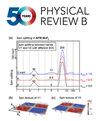理想陈氏带对称性的破缺
IF 3.7
2区 物理与天体物理
Q1 Physics and Astronomy
引用次数: 0
摘要
最近对莫尔材料中分数反常量子霍尔效应的观察,重新点燃了人们对分数陈氏绝缘体(FCIs)的兴趣。解析类朗道能级单粒子态形成“理想”陈恩带的手性极限和局部相互作用导致1/3填充处的类劳克林fci,通过将它们与最低朗道能级联系起来,对理解这些系统非常有用。然而,我们证明,即使在理想的手性极限下,波动量子几何也与强破缺对称性和与朗道能级非常不同的现象学相关联。特别是,粒子-空穴对称性被强烈破坏,例如,在2/3填充时,一个没有朗道能级对应的紧急相互作用驱动的费米液态在能量上是有利的。事实上,在1/3填充时,即使是完全类似于laughlin的零模式,也具有跟踪底层量子几何的非均匀密度。切换到库仑相互作用,当电子填充为1/4时,理想的chen带具有平凡的电荷密度波态。此外,应用粒子-空穴变换表明,当空穴填充为3/4时,理想的陈恩带支持量子化霍尔电导为e2/h的量子反常霍尔晶体。这些现象没有直接的最低朗道水平对应。2025年由美国物理学会出版本文章由计算机程序翻译,如有差异,请以英文原文为准。
Broken symmetry in ideal Chern bands
Recent observations of the fractional anomalous quantum Hall effect in moiré materials have reignited the interest in fractional Chern insulators (FCIs). The chiral limit in which analytic Landau-level-like single-particle states form an “ideal” Chern band and local interactions lead to Laughlin-like FCIs at 1/3 filling has been very useful for understanding these systems by relating them to the lowest Landau level. We show, however, that, even in the idealized chiral limit, a fluctuating quantum geometry is associated with strongly broken symmetries and a phenomenology very different from that of Landau levels. In particular, particle-hole symmetry is strongly violated and, e.g., at 2 / 3 1 / 3 1 / 4 3 / 4 e 2 / h Published by the American Physical Society 2025
求助全文
通过发布文献求助,成功后即可免费获取论文全文。
去求助
来源期刊

Physical Review B
物理-物理:凝聚态物理
CiteScore
6.70
自引率
32.40%
发文量
0
审稿时长
3.0 months
期刊介绍:
Physical Review B (PRB) is the world’s largest dedicated physics journal, publishing approximately 100 new, high-quality papers each week. The most highly cited journal in condensed matter physics, PRB provides outstanding depth and breadth of coverage, combined with unrivaled context and background for ongoing research by scientists worldwide.
PRB covers the full range of condensed matter, materials physics, and related subfields, including:
-Structure and phase transitions
-Ferroelectrics and multiferroics
-Disordered systems and alloys
-Magnetism
-Superconductivity
-Electronic structure, photonics, and metamaterials
-Semiconductors and mesoscopic systems
-Surfaces, nanoscience, and two-dimensional materials
-Topological states of matter
 求助内容:
求助内容: 应助结果提醒方式:
应助结果提醒方式:


